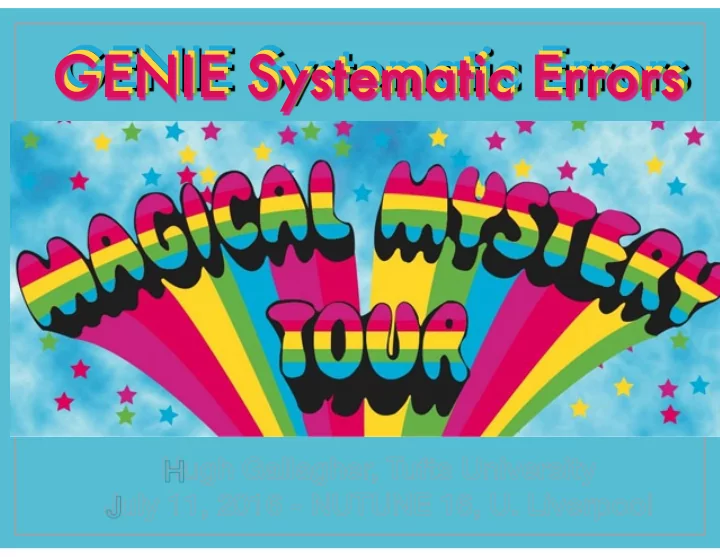

GENIE Systematic Errors GENIE Systematic Errors GENIE Systematic Errors Hugh Gallagher, Tufts University July 11, 2016 - NUTUNE 16, U. Liverpool
OUTLINE 1) History/Context 2) Neutrino-Nucleon Interaction Modeling • Free nucleon cross section model • Free nucleon hadronization model 3) Neutrino-Nucleus Interaction Modeling • The intranuclear rescattering model 4) Lessons Learned / Thoughts for the Future NUTUNE 2016 H. Gallagher, July 12, 2016 � 2
Q: Where do GENIE’s estimates for systematic errors come from? � � A: This is Easy!!! $GENIE/src/GSystUncertainty.cxx � 3
//_______________________________________________________________ // From Debdatta's thesis: void GSystUncertainty::SetDefaults(void) // Aht = 0.538 +/- 0.134 { // Bht = 0.305 +/- 0.076 this->SetUncertainty( kXSecTwkDial_MaNCEL, 0.25, 0.25); // CV1u = 0.291 +/- 0.087 this->SetUncertainty( kXSecTwkDial_EtaNCEL, 0.30, 0.30); // CV2u = 0.189 +/- 0.076 this->SetUncertainty( kXSecTwkDial_NormCCQE, 0.20, 0.15); � this->SetUncertainty( kXSecTwkDial_MaCCQEshape, 0.10, 0.10); this->SetUncertainty( kXSecTwkDial_AhtBY, 0.25, 0.25); this->SetUncertainty( kXSecTwkDial_MaCCQE, 0.25, 0.15); this->SetUncertainty( kXSecTwkDial_BhtBY, 0.25, 0.25); this->SetUncertainty( kXSecTwkDial_ZNormCCQE, 0.20, 0.15); this->SetUncertainty( kXSecTwkDial_CV1uBY, 0.30, 0.30); this->SetUncertainty( kXSecTwkDial_ZExpA1CCQE, 0.14, 0.14); this->SetUncertainty( kXSecTwkDial_CV2uBY, 0.40, 0.40); this->SetUncertainty( kXSecTwkDial_ZExpA2CCQE, 0.67, 0.67); � this->SetUncertainty( kXSecTwkDial_ZExpA3CCQE, 1.00, 1.00); this->SetUncertainty( kXSecTwkDial_AhtBYshape, 0.25, 0.25); this->SetUncertainty( kXSecTwkDial_ZExpA4CCQE, 0.75, 0.75); this->SetUncertainty( kXSecTwkDial_BhtBYshape, 0.25, 0.25); this->SetUncertainty( kXSecTwkDial_NormCCRES, 0.20, 0.20); this->SetUncertainty( kXSecTwkDial_CV1uBYshape, 0.30, 0.30); this->SetUncertainty( kXSecTwkDial_MaCCRESshape, 0.10, 0.10); this->SetUncertainty( kXSecTwkDial_CV2uBYshape, 0.40, 0.40); this->SetUncertainty( kXSecTwkDial_MvCCRESshape, 0.05, 0.05); � this->SetUncertainty( kXSecTwkDial_MaCCRES, 0.20, 0.20); this->SetUncertainty( kXSecTwkDial_DISNuclMod, 1.00, 1.00); this->SetUncertainty( kXSecTwkDial_MvCCRES, 0.10, 0.10); this->SetUncertainty( kSystNucl_CCQEPauliSupViaKF, 0.30, 0.30); this->SetUncertainty( kXSecTwkDial_NormNCRES, 0.20, 0.20); this->SetUncertainty( kHadrAGKYTwkDial_xF1pi, 0.20, 0.20); this->SetUncertainty( kXSecTwkDial_MaNCRESshape, 0.10, 0.10); this->SetUncertainty( kHadrAGKYTwkDial_pT1pi, 0.03, 0.03); this->SetUncertainty( kXSecTwkDial_MvNCRESshape, 0.05, 0.05); this->SetUncertainty( kHadrNuclTwkDial_FormZone, 0.50, 0.50); this->SetUncertainty( kXSecTwkDial_MaNCRES, 0.20, 0.20); � this->SetUncertainty( kXSecTwkDial_MvNCRES, 0.10, 0.10); // From INTRANUKE pi+A and N+A mode comparisons with hadron this->SetUncertainty( kXSecTwkDial_MaCOHpi, 0.40, 0.40); scattering data: this->SetUncertainty( kXSecTwkDial_R0COHpi, 0.10, 0.10); // this->SetUncertainty( kXSecTwkDial_RvpCC1pi, 0.50, 0.50); this->SetUncertainty( kINukeTwkDial_MFP_pi, 0.20, 0.20); this->SetUncertainty( kXSecTwkDial_RvpCC2pi, 0.50, 0.50); this->SetUncertainty( kINukeTwkDial_MFP_N, 0.20, 0.20); this->SetUncertainty( kXSecTwkDial_RvpNC1pi, 0.50, 0.50); this->SetUncertainty( kINukeTwkDial_FrCEx_pi, 0.50, 0.50); this->SetUncertainty( kXSecTwkDial_RvpNC2pi, 0.50, 0.50); this->SetUncertainty( kINukeTwkDial_FrElas_pi, 0.10, 0.10); this->SetUncertainty( kXSecTwkDial_RvnCC1pi, 0.50, 0.50); this->SetUncertainty( kINukeTwkDial_FrInel_pi, 0.40, 0.40); this->SetUncertainty( kXSecTwkDial_RvnCC2pi, 0.50, 0.50); this->SetUncertainty( kINukeTwkDial_FrAbs_pi, 0.30, 0.30); this->SetUncertainty( kXSecTwkDial_RvnNC1pi, 0.50, 0.50); this->SetUncertainty( kINukeTwkDial_FrPiProd_pi, 0.20, 0.20); this->SetUncertainty( kXSecTwkDial_RvnNC2pi, 0.50, 0.50); this->SetUncertainty( kINukeTwkDial_FrCEx_N, 0.50, 0.50); this->SetUncertainty( kXSecTwkDial_RvbarpCC1pi, 0.50, 0.50); this->SetUncertainty( kINukeTwkDial_FrElas_N, 0.30, 0.30); this->SetUncertainty( kXSecTwkDial_RvbarpCC2pi, 0.50, 0.50); this->SetUncertainty( kINukeTwkDial_FrInel_N, 0.40, 0.40); this->SetUncertainty( kXSecTwkDial_RvbarpNC1pi, 0.50, 0.50); this->SetUncertainty( kINukeTwkDial_FrAbs_N, 0.20, 0.20); this->SetUncertainty( kXSecTwkDial_RvbarpNC2pi, 0.50, 0.50); this->SetUncertainty( kINukeTwkDial_FrPiProd_N, 0.20, 0.20); this->SetUncertainty( kXSecTwkDial_RvbarnCC1pi, 0.50, 0.50); � this->SetUncertainty( kXSecTwkDial_RvbarnCC2pi, 0.50, 0.50); this->SetUncertainty( kRDcyTwkDial_BR1gamma, 0.50, 0.50); this->SetUncertainty( kXSecTwkDial_RvbarnNC1pi, 0.50, 0.50); this->SetUncertainty( kRDcyTwkDial_BR1eta, 0.50, 0.50); this->SetUncertainty( kXSecTwkDial_RvbarnNC2pi, 0.50, 0.50); } � � NUTUNE 2016 H. Gallagher, July 12, 2016 � 4
� 5
History neugen3: HG, Nucl.Phys.Proc.Suppl. 112 (2002) 188-194 Many of the core GENIE models were first implemented in the neugen3 generator in 2005-2006: � Free nucleon cross section model hA intranuclear rescattering model • S. Dytman, HG, M. Kordosky, arXiv:0806:2119 (2008). AGKY hadronization model • T. Yang et al., Eur.Phys.J. C63 (2009) 1-10. • T. Yang and J. Boehm Ph. D Theses (MINOS). � � Adamson et al., Phys.Rev.Lett. 110 (2013) 251801 Like GENIE, neugen3 was publicly available, but unlike GENIE, was not ‘universal’, and development was focussed on the needs of its main user, MINOS . � As a ‘single user’ activity, e ff ort was available, but deadlines were pretty strict. � NUTUNE 2016 H. Gallagher, July 12, 2016 � 6
History Since MINOS is an oscillation experiment and has a Near Detector, the generator was essentially providing an ‘e ff ective model’. � Two bursts of activity: • Development of models that could reasonably accurately describe the Near Detector data (CC inclusive, hadronization model). • Discussions about the assignment of systematic errors for these models. � In the context of an oscillation fit, the question was not how good the model is , but how wrong it could be. � Involved many Minoans: C. Andreopoulos, D. Bhattacharya, J. Boehm, S. Dytman, HG, R. Gran, R. Hatcher, M. Kordosky, T. Mann, D. Michael, S. Mishra, J. Morfin, D. Naples, T. Yang. � Incorporated into GENIE and updated in T2K studies (2010) by C. Andreopoulos, J. Dobson +. NUTUNE 2016 H. Gallagher, July 12, 2016 � 7 �
Stages of Generation C. Andreopoulos nuclear model primary interaction hadronization intranuclear (cross section) hadron transport NUTUNE 2016 H. Gallagher, July 12, 2016 � 8
Recommend
More recommend